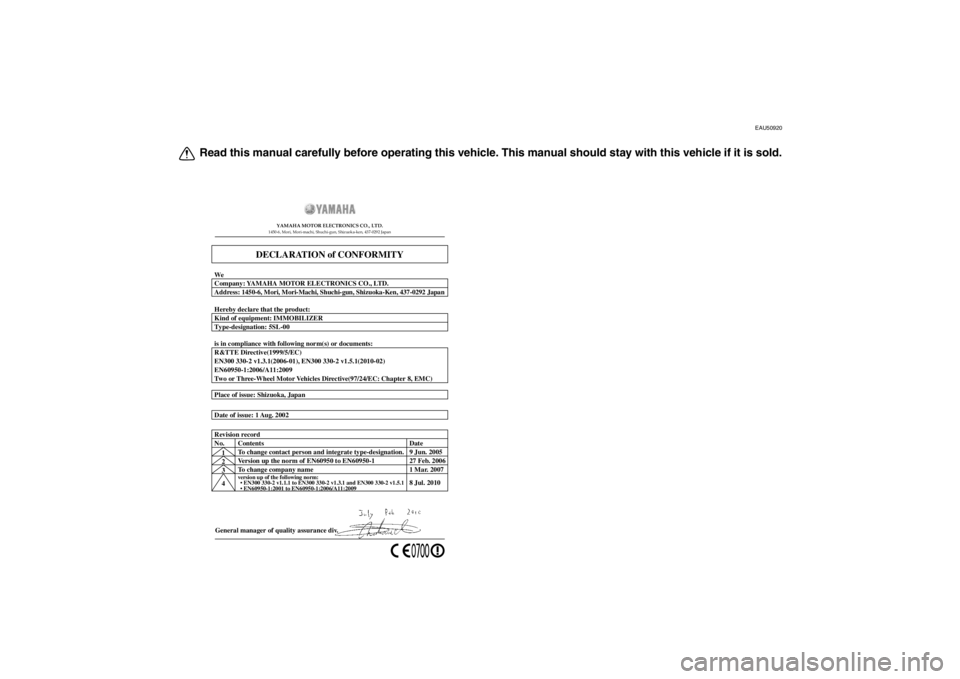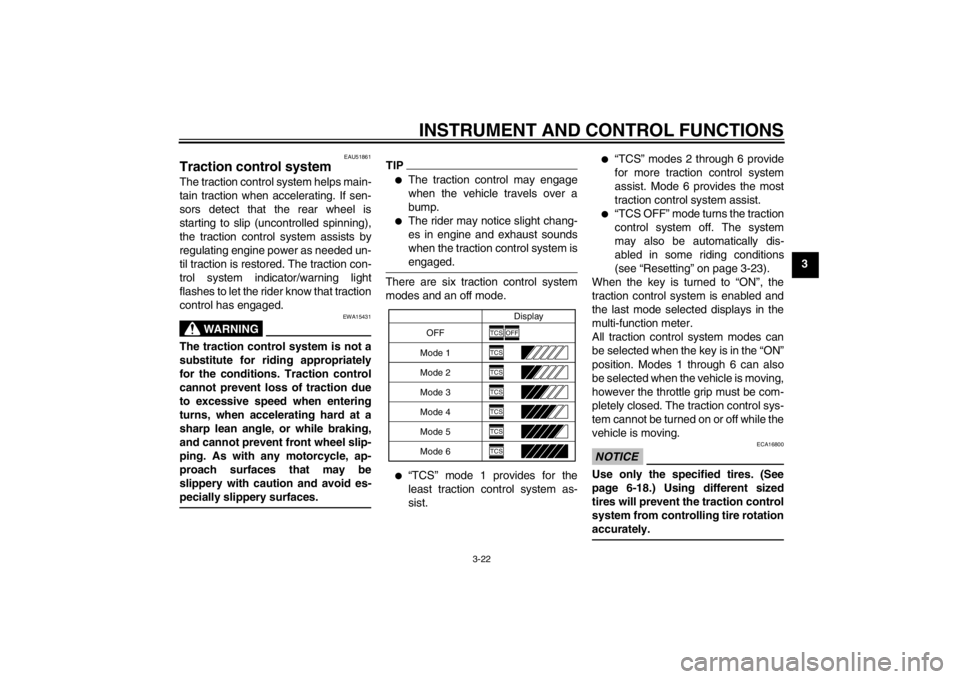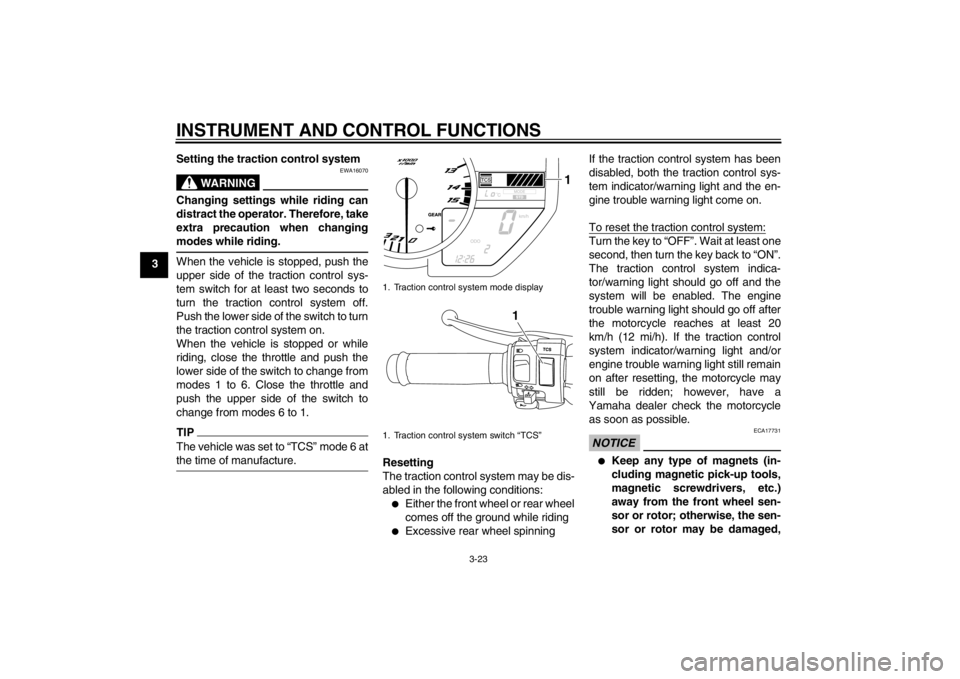wheel YAMAHA YZF-R1 2012 Owners Manual
[x] Cancel search | Manufacturer: YAMAHA, Model Year: 2012, Model line: YZF-R1, Model: YAMAHA YZF-R1 2012Pages: 112, PDF Size: 2.78 MB
Page 2 of 112

EAU50920
Read this manual carefully before operating this vehicle. This manual should stay with this vehicle if it is sold.
General manager of quality assurance div.
Date of issue: 1 Aug. 2002 Place of issue: Shizuoka, Japan
DECLARATION of CONFORMITY
YAMAHA MOTOR ELECTRONICS CO., LTD.1450-6, Mori, Mori-machi, Shuchi-gun, Shizuoka-ken, 437-0292 Japan
Company: YAMAHA MOTOR ELECTRONICS CO., LTD. We
Address: 1450-6, Mori, Mori-Machi, Shuchi-gun, Shizuoka-Ken, 437-0292 Japan
Kind of equipment: IMMOBILIZER Hereby declare that the product:
Type-designation: 5SL-00
is in compliance with following norm(s) or documents:
R&TTE Directive(1999/5/EC)
EN300 330-2 v1.3.1(2006-01), EN300 330-2 v1.5.1(2010-02)
EN60950-1:2006/A11:2009
Two or Three-Wheel Motor Vehicles Directive(97/24/EC: Chapter 8, EMC)
1
2
3
4 Version up the norm of EN60950 to EN60950-1
To change company name
version up of the following norm:
• EN300 330-2 v1.1.1 to EN300 330-2 v1.3.1 and EN300 330-2 v1.5.1
27 Feb. 2006
1 Mar. 2007
8 Jul. 2010
Revision record
No. Contents
To change contact person and integrate type-designation. Date
9 Jun. 2005
U1KBE0E0.book Page 1 Monday, July 25, 2011 5:03 PM
Page 6 of 112

TABLE OF CONTENTSSAFETY INFORMATION ..................1-1
DESCRIPTION ..................................2-1
Left view ..........................................2-1
Right view ........................................2-2
Controls and instruments.................2-3
INSTRUMENT AND CONTROL
FUNCTIONS .......................................3-1
D-mode (drive mode) ......................3-1
Immobilizer system .........................3-1
Main switch/steering lock ................3-3
Indicator lights and warning lights ..............................3-4
Multi-function meter unit .................3-9
Anti-theft alarm (optional) .............3-18
Handlebar switches ......................3-18
Clutch lever ...................................3-20
Shift pedal .....................................3-20
Brake lever ...................................3-21
Brake pedal ..................................3-21
Traction control system ................3-22
Fuel tank cap ................................3-24
Fuel ...............................................3-25
Fuel tank breather hose and overflow hose ............................3-26
Catalytic converter ........................3-26
Seats ............................................3-27
Helmet holder ...............................3-28
Storage compartment ...................3-29
Rider footrest position ...................3-30 Rear view mirrors ......................... 3-30
Adjusting the front fork ................. 3-30
Adjusting the shock absorber
assembly ................................... 3-32
Luggage strap holders ................. 3-35
Sidestand ..................................... 3-35
Ignition circuit cut-off system ........ 3-36
FOR YOUR SAFETY –
PRE-OPERATION CHECKS ............. 4-1
OPERATION AND IMPORTANT
RIDING POINTS ................................. 5-1
Starting the engine ......................... 5-1
Shifting ........................................... 5-2
Tips for reducing fuel consumption ............................... 5-3
Engine break-in .............................. 5-3
Parking ........................................... 5-4
PERIODIC MAINTENANCE AND
ADJUSTMENT ................................... 6-1
Owner’s tool kit ............................... 6-2
Periodic maintenance chart for
the emission control system ....... 6-3
General maintenance and
lubrication chart .......................... 6-4
Removing and installing cowlings ...................................... 6-8
Checking the spark plugs ............. 6-10
Engine oil and oil filter cartridge ... 6-11 Coolant ........................................ 6-14
Air filter element ........................... 6-17
Checking the engine idling
speed ........................................ 6-17
Checking the throttle grip free
play ........................................... 6-18
Valve clearance ........................... 6-18
Tires ............................................. 6-18
Cast wheels ................................. 6-21
Adjusting the clutch lever free play ........................................... 6-21
Checking the brake lever free play ........................................... 6-22
Brake light switches ..................... 6-22
Checking the front and
rear brake pads ........................ 6-23
Checking the brake fluid level ...... 6-23
Changing the brake fluid .............. 6-25
Drive chain slack .......................... 6-25
Cleaning and lubricating
the drive chain .......................... 6-26
Checking and lubricating the cables ................................. 6-27
Checking and lubricating the throttle grip and cable ......... 6-27
Checking and lubricating
the brake and shift pedals ........ 6-28
Checking and lubricating the brake and clutch levers ...... 6-28
Checking and lubricating the sidestand ............................ 6-29U1KBE0E0.book Page 1 Monday, July 25, 2011 5:03 PM
Page 7 of 112

TABLE OF CONTENTS
Lubricating the swingarm pivots ... 6-29
Checking the front fork ................. 6-30
Checking the steering ................... 6-30
Checking the wheel bearings ....... 6-31
Battery .......................................... 6-31
Replacing the fuses ...................... 6-33
Replacing a headlight bulb ........... 6-34
Tail/brake light .............................. 6-35
Replacing a turn signal light bulb ........................................... 6-36
Replacing the license plate light
bulb ........................................... 6-36
Auxiliary light ................................ 6-37
Supporting the motorcycle ............ 6-37
Troubleshooting ............................ 6-38
Troubleshooting charts ................. 6-39
MOTORCYCLE CARE AND
STORAGE .......................................... 7-1
Matte color caution ......................... 7-1
Care ................................................ 7-1
Storage ...........................................7-4
SPECIFICATIONS ............................. 8-1
CONSUMER INFORMATION ............. 9-1
Identification numbers .................... 9-1
U1KBE0E0.book Page 2 Monday, July 25, 2011 5:03 PM
Page 9 of 112

SAFETY INFORMATION
1-2
1
due to excessive speed or under-
cornering (insufficient lean angle
for the speed).
Always obey the speed limit and never travel faster than warrant-
ed by road and traffic conditions.
Always signal before turning or changing lanes. Make sure that
other motorists can see you.
●
The posture of the operator and
passenger is important for proper
control. The operator should keep both hands on the handlebar and
both feet on the operator foot-
rests during operation to main-
tain control of the motorcycle.
The passenger should always hold onto the operator, the seat
strap or grab bar, if equipped,
with both hands and keep both
feet on the passenger footrests.
Never carry a passenger unless
he or she can firmly place both
feet on the passenger footrests.
●
Never ride under the influence of
alcohol or other drugs.
●
This motorcycle is designed for on-
road use only. It is not suitable for
off-road use.
Protective Apparel
The majority of fatalities from motorcy-
cle accidents are the result of head in-
juries. The use of a safety helmet is the
single most critical factor in the preven-
tion or reduction of head injuries.
●
Always wear an approved helmet.
●
Wear a face shield or goggles.
Wind in your unprotected eyes
could contribute to an impairment
of vision that could delay seeing a
hazard.
●
The use of a jacket, heavy boots,
trousers, gloves, etc., is effective in
preventing or reducing abrasions
or lacerations.
●
Never wear loose-fitting clothes,
otherwise they could catch on the
control levers, footrests, or wheels
and cause injury or an accident.
●
Always wear protective clothing
that covers your legs, ankles, and
feet. The engine or exhaust sys-
tem become very hot during or af-
ter operation and can cause burns.
●
A passenger should also observe
the above precautions.
Avoid Carbon Monoxide Poisoning
All engine exhaust contains carbon
monoxide, a deadly gas. Breathing car-
bon monoxide can cause headaches,
dizziness, drowsiness, nausea, confu-
sion, and eventually death.
Carbon Monoxide is a colorless, odor-
less, tasteless gas which may be
present even if you do not see or smell
any engine exhaust. Deadly levels of
carbon monoxide can collect rapidly
and you can quickly be overcome and
unable to save yourself. Also, deadly
levels of carbon monoxide can linger
for hours or days in enclosed or poorly
ventilated areas. If you experience any
symptoms of carbon monoxide poison-
ing, leave the area immediately, get
fresh air, and SEEK MEDICAL TREAT-
MENT.
●
Do not run engine indoors. Even if
you try to ventilate engine exhaust
with fans or open windows and
doors, carbon monoxide can rap-
idly reach dangerous levels.
U1KBE0E0.book Page 2 Monday, July 25, 2011 5:03 PM
Page 12 of 112

SAFETY INFORMATION
1-5
1
●
Check that the fuel cock (if
equipped) is in the “OFF” position
and that there are no fuel leaks.
●
Point the front wheel straight
ahead on the trailer or in the truck
bed, and choke it in a rail to pre-
vent movement.
●
Shift the transmission in gear (for
models with a manual transmis-
sion).
●
Secure the motorcycle with tie-
downs or suitable straps that are
attached to solid parts of the mo-
torcycle, such as the frame or up-
per front fork triple clamp (and not,
for example, to rubber-mounted
handlebars or turn signals, or parts
that could break). Choose the lo-
cation for the straps carefully so
the straps will not rub against
painted surfaces during transport.
●
The suspension should be com-
pressed somewhat by the tie-
downs, if possible, so that the mo-
torcycle will not bounce excessive-
ly during transport.
U1KBE0E0.book Page 5 Monday, July 25, 2011 5:03 PM
Page 37 of 112

INSTRUMENT AND CONTROL FUNCTIONS
3-22
3
EAU51861
Traction control system The traction control system helps main-
tain traction when accelerating. If sen-
sors detect that the rear wheel is
starting to slip (uncontrolled spinning),
the traction control system assists by
regulating engine power as needed un-
til traction is restored. The traction con-
trol system indicator/warning light
flashes to let the rider know that traction
control has engaged.
WARNING
EWA15431
The traction control system is not a
substitute for riding appropriately
for the conditions. Traction control
cannot prevent loss of traction due
to excessive speed when entering
turns, when accelerating hard at a
sharp lean angle, or while braking,
and cannot prevent front wheel slip-
ping. As with any motorcycle, ap-
proach surfaces that may be
slippery with caution and avoid es-
pecially slippery surfaces.
TIP●
The traction control may engage
when the vehicle travels over a
bump.
●
The rider may notice slight chang-
es in engine and exhaust sounds
when the traction control system is
engaged.
There are six traction control system
modes and an off mode.●
“TCS” mode 1 provides for the
least traction control system as-
sist.
●
“TCS” modes 2 through 6 provide
for more traction control system
assist. Mode 6 provides the most
traction control system assist.
●
“TCS OFF” mode turns the traction
control system off. The system
may also be automatically dis-
abled in some riding conditions
(see “Resetting” on page 3-23).
When the key is turned to “ON”, the
traction control system is enabled and
the last mode selected displays in the
multi-function meter.
All traction control system modes can
be selected when the key is in the “ON”
position. Modes 1 through 6 can also
be selected when the vehicle is moving,
however the throttle grip must be com-
pletely closed. The traction control sys-
tem cannot be turned on or off while the
vehicle is moving.
NOTICE
ECA16800
Use only the specified tires. (See
page 6-18.) Using different sized
tires will prevent the traction control
system from controlling tire rotation
accurately.
OFF Display
Mode 1
Mode 2
Mode 3
Mode 4
Mode 5
Mode 6
TCS
OFF
TCSTCSTCSTCSTCSTCS
U1KBE0E0.book Page 22 Monday, July 25, 2011 5:03 PM
Page 38 of 112

INSTRUMENT AND CONTROL FUNCTIONS
3-23
3Setting the traction control system
WARNING
EWA16070
Changing settings while riding can
distract the operator. Therefore, take
extra precaution when changing
modes while riding.When the vehicle is stopped, push the
upper side of the traction control sys-
tem switch for at least two seconds to
turn the traction control system off.
Push the lower side of the switch to turn
the traction control system on.
When the vehicle is stopped or while
riding, close the throttle and push the
lower side of the switch to change from
modes 1 to 6. Close the throttle and
push the upper side of the switch to
change from modes 6 to 1.TIPThe vehicle was set to “TCS” mode 6 at
the time of manufacture.
Resetting
The traction control system may be dis-
abled in the following conditions:●
Either the front wheel or rear wheel
comes off the ground while riding
●
Excessive rear wheel spinning If the traction control system has been
disabled, both the traction control sys-
tem indicator/warning light and the en-
gine trouble warning light come on.
To reset the traction control system:
Turn the key to “OFF”. Wait at least one
second, then turn the key back to “ON”.
The traction control system indica-
tor/warning light should go off and the
system will be enabled. The engine
trouble warning light should go off after
the motorcycle reaches at least 20
km/h (12 mi/h). If the traction control
system indicator/warning light and/or
engine trouble warning light still remain
on after resetting, the motorcycle may
still be ridden; however, have a
Yamaha dealer check the motorcycle as soon as possible.NOTICE
ECA17731
●
Keep any type of magnets (in-
cluding magnetic pick-up tools,
magnetic screwdrivers, etc.)
away from the front wheel sen-
sor or rotor; otherwise, the sen-
sor or rotor may be damaged,
1. Traction control system mode display
1. Traction control system switch “TCS”
1
1
U1KBE0E0.book Page 23 Monday, July 25, 2011 5:03 PM
Page 39 of 112

INSTRUMENT AND CONTROL FUNCTIONS
3-24
3
resulting in improper perfor-
mance of the traction control
system.
●
Be careful not to damage the
sensor or rotor.
EAU13074
Fuel tank cap To open the fuel tank cap
Open the fuel tank cap lock cover, in-
sert the key into the lock, and then turn
it 1/4 turn clockwise. The lock will be re-
leased and the fuel tank cap can be
opened.
To close the fuel tank cap
1. Push the fuel tank cap into position with the key inserted in the lock.
2. Turn the key counterclockwise to the original position, remove it, and
then close the lock cover.
TIPThe fuel tank cap cannot be closed un-
less the key is in the lock. In addition,
the key cannot be removed if the cap is
not properly closed and locked.
WARNING
EWA11091
Make sure that the fuel tank cap is
properly closed after filling fuel.
Leaking fuel is a fire hazard.
1. Front wheel sensor rotor
2. Front wheel sensor
2
1
1. Fuel tank cap lock cover
2. Unlock.
U1KBE0E0.book Page 24 Monday, July 25, 2011 5:03 PM
Page 54 of 112

FOR YOUR SAFETY – PRE-OPERATION CHECKS
4-2
4
Rear brake Check operation.
If soft or spongy, have Yamaha dealer bleed hydraulic system.
Check brake pads for wear.
Replace if necessary.
Check fluid level in reservoir.
If necessary, add specified brake fluid to specified level.
Check hydraulic system for leakage. 6-23, 6-23
Clutch Check operation.
Lubricate cable if necessary.
Check lever free play.
Adjust if necessary.
6-21
Throttle grip Make sure that operation is smooth.
Check throttle grip free play.
If necessary, have Yamaha dealer adjust throttle grip free play and lubricate cable
and grip housing. 6-18, 6-27
Control cables Make sure that operation is smooth.
Lubricate if necessary. 6-27
Drive chain Check chain slack.
Adjust if necessary.
Check chain condition.
Lubricate if necessary.
6-25, 6-26
Wheels and tires Check for damage.
Check tire condition and tread depth.
Check air pressure.
Correct if necessary.
6-18, 6-21
Brake and shift pedals Make sure that operation is smooth.
Lubricate pedal pivoting points if necessary. 6-28
Brake and clutch levers Make sure that operation is smooth.
Lubricate lever pivoting points if necessary.
6-28
Sidestand Make sure that operation is smooth.
Lubricate pivot if necessary.
6-29
ITEM CHECKS PAGE
U1KBE0E0.book Page 2 Monday, July 25, 2011 5:03 PM
Page 63 of 112

PERIODIC MAINTENANCE AND ADJUSTMENT
6-4
6
EAU1770C
General maintenance and lubrication chart NO. ITEM CHECK OR MAINTENANCE JOB ODOMETER READING
ANNUAL
CHECK
1000 km
(600 mi) 10000 km
(6000 mi) 20000 km
(12000 mi) 30000 km
(18000 mi) 40000 km
(24000 mi)
1 *Air filter element Replace. √
2Clutch Check operation.
Adjust.
√√√√√
3 *Front brake Check operation, fluid level and
vehicle for fluid leakage. √√√√√√
Replace brake pads. Whenever worn to the limit
4 *Rear brake Check operation, fluid level and
vehicle for fluid leakage. √√√√√√
Replace brake pads. Whenever worn to the limit
5 *Brake hoses Check for cracks or damage.
Check for correct routing and
clamping. √√√√√
Replace. Every 4 years
6 *Wheels Check runout and for damage. √√√√
7 *Tires Check tread depth and for dam-
age.
Replace if necessary.
Check air pressure.
Correct if necessary. √√√√√
8 *Wheel bearings Check bearing for looseness or
damage. √√√√
U1KBE0E0.book Page 4 Monday, July 25, 2011 5:03 PM